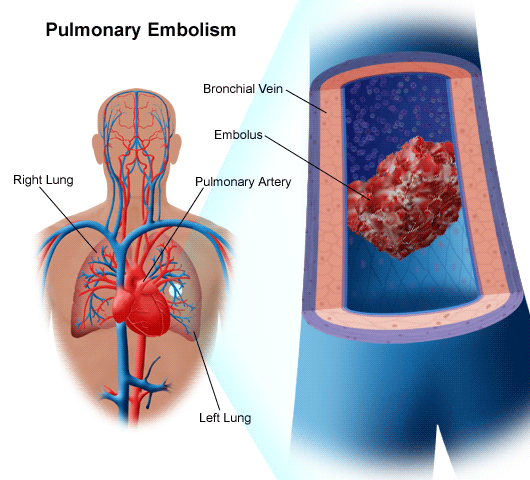If you’ve been coughing recently, then take some medicine for cough and colds to make it go away. But if it still persists, you’d better head over to your doctor since you probably have lung problems. Coughing is a symptom of numerous illnesses. While in most cases, it’s just a mild cold, there are some instances that it could also mean severe pulmonary embolism. Heard about that disease before? If not (and you want to know more about it), then we suggest you read on below.
Definition

Pulmonary embolism occurs when there is blood clotting present in one of the arteries located in your lungs. It could also have been formed in any of the smaller blood vessels in other parts of your body such as your arms, legs, pelvis or even your heart before travelling through your bloodstream and lodging itself in your lungs. It can cause significant damage not only to your respiratory system, but to the rest of your body as well since it can lower the blood's oxygen levels and restrict the blood flow.
Causes and Risks
Most pulmonary embolism cases are caused by deep vein thrombosis, a condition wherein blood clots form within the veins of your legs. When these blood clots break loose, they can travel up to the lungs, thus causing pulmonary embolism.
Aside from this, pulmonary embolism can also be caused by genetic blood disorders, recent surgeries, and burns. Immobilization due to stroke and spinal injury increases the chances for blood clot formation as well. Other contributing factors include heart disease, smoking, pregnancy and obesity.
Symptoms
The symptoms of pulmonary embolism depends on how large the blood clot is and where is it lodged in your lungs. In general, the common symptoms of pulmonary embolism include difficulty in breathing, coughing, and chest pain. You may also feel other signs like leg pain, fever, clammy skin, rapid heart beating, dizziness and anxiety.
Diagnosis

Unfortunately, it can be difficult to ascertain if someone has pulmonary embolism, especially if the patient has records of preexisting respiratory and cardio problems. In any case, your pulmonologist will request several tests to confirm the diagnosis, including Ultrasounds, Lung Ventilation Scans, chest X-rays, and blood tests.
Treatment
Like its diagnosis, treatment of this lung problem depends on the size and location of the blood clot. If the problem was detected early on, your doctor may prescribe anticoagulant and thrombolytic medications to abate blood clotting in your body. However, doctors recommend surgeries in more severe cases, and these procedures often include clot removal and vein filtering.
Prevention
Preventing internal blood clotting (and thus pulmonary embolism) is relatively easy. Methods you can try out include doing exercises like pneumatic compression and leg elevation, and wearing compression stockings. A few lifestyle adjustments would also be helpful.
Remember that pulmonary embolism can be fatal if left unaddressed. So immediately proceed to the nearest medical institution if you think you have blood clots in your lungs. That way, you’ll be given proper treatment as soon as possible.